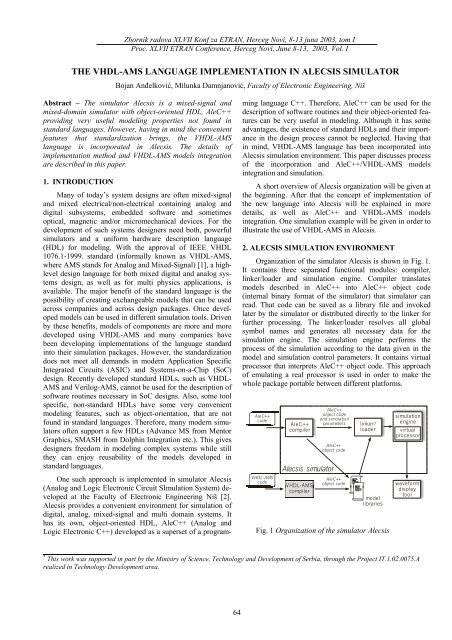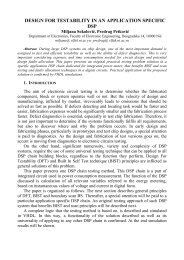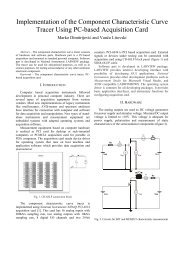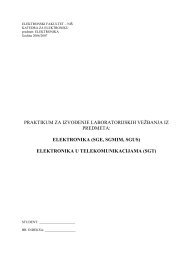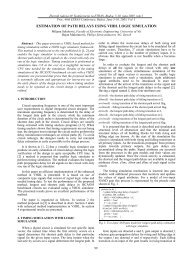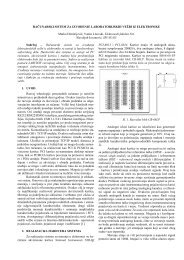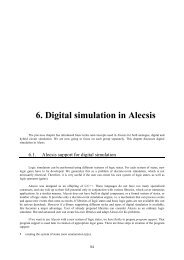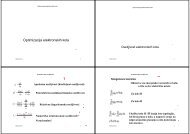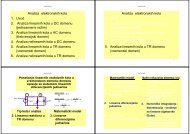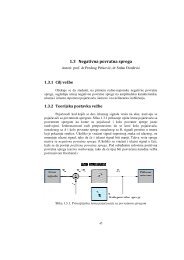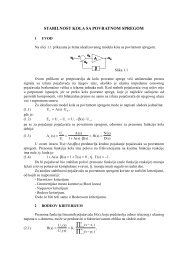the vhdl-ams language implementation in alecsis simulator - LEDA
the vhdl-ams language implementation in alecsis simulator - LEDA
the vhdl-ams language implementation in alecsis simulator - LEDA
Create successful ePaper yourself
Turn your PDF publications into a flip-book with our unique Google optimized e-Paper software.
model is used for construct<strong>in</strong>g nodes <strong>in</strong> hierarchicaldescriptions when <strong>the</strong> models are <strong>in</strong>stantiated.AleC++ uses <strong>the</strong> element called l<strong>in</strong>k for represent<strong>in</strong>g <strong>the</strong>unknowns <strong>in</strong> <strong>the</strong> system of equations [2]. It can be of onefrom five different types: node, current, flow, charge andsignal. Therefore, electrical across quantities <strong>in</strong> VHDL-AMScorrespond to <strong>the</strong> difference of voltage nodes, nodes toterm<strong>in</strong>als and electrical through quantities to current. Freequantities <strong>in</strong> VHDL-AMS have flows as <strong>the</strong>ir counterparts <strong>in</strong>AleC++. S<strong>in</strong>ce Alecsis does not make any difference betweennonelectrical across and through quantities all of <strong>the</strong>m can betreated as flows.Relationships between quantities <strong>in</strong> VHDL-AMS areexpressed by us<strong>in</strong>g simple simultaneous statements [1].Similar constructs for describ<strong>in</strong>g equations exist <strong>in</strong> AleC++:one for non-conservative and two for conservative systems.Therefore, similar functions <strong>in</strong> both AleC++ and VHDL-AMS compilers can be used for determ<strong>in</strong><strong>in</strong>g contributions of<strong>the</strong> equations to <strong>the</strong> system matrix. Nodes to which <strong>the</strong>equation contributes are term<strong>in</strong>als for <strong>the</strong> appropriate acrossor through quantities. In order to determ<strong>in</strong>e term<strong>in</strong>alscorrespond<strong>in</strong>g to <strong>the</strong> across or through quantity appear<strong>in</strong>g <strong>in</strong><strong>the</strong> equation, <strong>the</strong> term<strong>in</strong>al names are stored when quantitiesare declared toge<strong>the</strong>r with <strong>the</strong> name and type of quantity –through or across. The system of equations is <strong>the</strong>n formed byevaluat<strong>in</strong>g simple simultaneous statements and by resolv<strong>in</strong>gterm<strong>in</strong>al and quantity declarations.VHDL-AMS attributes for derivative and <strong>in</strong>tegrationover time exist <strong>in</strong> AleC++, too, so <strong>the</strong>y can be easilyimplemented <strong>in</strong> VHDL-AMS compiler.VHDL-AMS provides conditional and selected forms of<strong>the</strong> simultaneous statement that allow choos<strong>in</strong>g appropriateequations depend<strong>in</strong>g on some condition(s). AleC++ alsoprovides such constructs, so <strong>the</strong>y can be parsed <strong>in</strong> VHDL-AMS compiler by us<strong>in</strong>g similar functions as <strong>in</strong> AleC++compiler.4. VHDL-AMS MODELS INTEGRATIONAs it can be seen <strong>in</strong> Fig. 3, every VHDL-AMSarchitecture with appropriate entity relates to one module <strong>in</strong>AleC++ and <strong>the</strong>y are compiled to <strong>the</strong> same library objects.Ano<strong>the</strong>r basic <strong>language</strong> element is function. Code comb<strong>in</strong><strong>in</strong>gunder this level is forbidden. VHDL-AMS/AleC++ models<strong>in</strong>teraction is enabled through <strong>the</strong> <strong>in</strong>stantiation of <strong>the</strong>components and call<strong>in</strong>g functions described <strong>in</strong> <strong>the</strong> o<strong>the</strong>rHDL. Thus, it is possible <strong>in</strong> VHDL-AMS models to usecomponents and call functions def<strong>in</strong>ed <strong>in</strong> AleC++ and viceversa [4].In order to <strong>in</strong>tegrate VHDL-AMS models with Alecsis itis also very important to establish data type correspondencebetween <strong>the</strong> HDLs. That task can be easily accomplisheds<strong>in</strong>ce both <strong>language</strong>s have <strong>the</strong> same mach<strong>in</strong>e representationof data types (Figure 4). Hav<strong>in</strong>g <strong>in</strong> m<strong>in</strong>d data type system <strong>in</strong>VHDL-AMS, branch quantities get <strong>the</strong>ir types from <strong>the</strong>nature of <strong>the</strong>ir plus and m<strong>in</strong>us term<strong>in</strong>als.ALEC++data types correspondencedoublereal<strong>in</strong>t <strong>in</strong>tegerstruct recordenum enumeration typeVHDL-AMSFig. 4. AleC++/VHDL-AMS data types correspondence5. SIMULATION EXAMPLEAs an example of VHDL-AMS models <strong>in</strong>tegration andsimulation, a model of Butterworth filter based on <strong>the</strong>example found <strong>in</strong> [5] is presented here. RC net and voltagecontrolled voltage source for <strong>the</strong> filter model are described asseparate VHDL-AMS components (Fig.5 and Fig.6). Bothcomponents are described by us<strong>in</strong>g simple simultaneousstatements with branch quantities.entity rcnet_e isgeneric (res<strong>in</strong>1, res<strong>in</strong>2: real;res1, res2, res3, res4, res5, res6,res7, res8, res9: real;resa: real;cap1, cap2, cap3, cap4: real);port (term<strong>in</strong>al t1, t2, t3, t4, t5, t6,t7, t8, t9, t10, gnd: electrical);end entity rcnet_e;architecture rcnet of rcnet_e isterm<strong>in</strong>al t11: electrical;quantity v1 across i1 through t4 tognd;quantity v2 across i2 through t5 tot4;...quantity vc3 across ic3 through t6 tot11;quantity vc4 across ic4 through t7 tognd;beg<strong>in</strong>i1 == 1/res1 * v1;i2 == 1/res2 * v2;...ic3 == cap3 * vc3'dot;ic4 == cap4 * vc4'dot;end architecture rcnet;Fig. 5. VHDL-AMS model for RC net of <strong>the</strong> filterentity vcvsgen_e isgeneric (ga<strong>in</strong>: real);port (term<strong>in</strong>al t1,t2,t3,t4:electrical);end entity vcvsgen_e;architecture vcvsgen of vcvsgen_e isquantity vout across iout through t1to t2;quantity vc across ic through t3 tot4;beg<strong>in</strong>vout == ga<strong>in</strong>*vc;end architecture vcvsgen;Fig. 6. VHDL-AMS model of voltage controlled voltagesourceThese components are <strong>in</strong>stantiated and <strong>the</strong> filter circuit iscreated (Fig. 7).entity filter_e is66
port (term<strong>in</strong>al f1, f2, f3, f4, f5, f6,f7, f8, f9, f10, fgnd: electrical);end entity filter_e;architecture filter of filter_e iscomponent vcvsgen...end component;component rcnet...end component;beg<strong>in</strong>g0: rcnet ...g1: vcvsgen ...g2: vcvsgen ...end architecture filter;Voltage (V)Fig. 7. VHDL-AMS model of Butterworth filterAleC++ code for <strong>the</strong> circuit verification is given <strong>in</strong>Figure 8, and appropriate simulation results are presented <strong>in</strong>Figure 9.#<strong>in</strong>clude #def<strong>in</strong>e Period 15 msmodule filter (node f1, f2, f3, f4,f5, f6, f7, f8, f9, f10, fgnd);module vcvsgen (node t1, t2, t3, t4)action (double ga<strong>in</strong>);module rcnet (node t1, t3, t4, t5, t7,t8, t9, gnd)action(double res<strong>in</strong>1, double res<strong>in</strong>2,double res1, double res2, double res3,double res4, double res5, double res6,double res7, double res8, double res9,double resa, double cap1, double cap2,double cap3, double cap4);library "filter";library "rcnet";library "vcvsgen";root test() {filter f1;vs<strong>in</strong> v<strong>in</strong>;v<strong>in</strong> (n1, 0){amp=10v;freq=159.1549431;}f1 (n1, n2, n3, v1, n5, n6, n7, v5,n9, n10, 0);Fig. 8. AleC++ code for <strong>the</strong> filter verification6. CONCLUSIONVHDL-AMS is a standard HDL provid<strong>in</strong>g <strong>the</strong> mixedsignalsolutions for <strong>the</strong> behavioural model<strong>in</strong>g of mixedanalog-digital and multi physics systems. Hav<strong>in</strong>g <strong>in</strong> m<strong>in</strong>d itsimportance for portability and reusability of created models,it has been <strong>in</strong>corporated <strong>in</strong> <strong>simulator</strong> Alecsis. On that way,designers can use already developed VHDL-AMS modelswhile exploit<strong>in</strong>g at <strong>the</strong> same time good features of a nonstandardHDL AleC++ to overcome limitations <strong>in</strong> standard<strong>language</strong>s.Time (s)Fig. 9. Butterworth filter simulation results. Traced signalsare voltages <strong>in</strong> some nodes of <strong>the</strong> circuitREFERENCES[1] ---, IEEE Standard VHDL Language Reference Manual(Integrated with VHDL-AMS changes) – IEEE Std 1076-1, draft version, New York IEEE, 1998.[2] Ž. Mrčarica et al., Alecsis 2.3, <strong>the</strong> <strong>simulator</strong> for circuitsand systems. User’s Manual, Laboratory for ElectronicDesign Automation, Faculty of Electronic Eng<strong>in</strong>eer<strong>in</strong>g,University of Niš, Yugoslavia, <strong>LEDA</strong> – 1/1998.[3] A. Aho, R.Sethi, J. Ullman, Compilers – Pr<strong>in</strong>ciples,Techniques and Tools, Addison Wesley Publish<strong>in</strong>gCompany, Read<strong>in</strong>g, Massachusetts, 1986.[4] V. Litovski, Ž. Dimić, M. Damnjanović and Ž. Mrčarica,“Electronic circuit simulation <strong>in</strong> a mixed-<strong>language</strong>environment”, Microelectronics journal, vol. 29, No. 8,pp. 553-558, 1998.[5] SEAMS Homepage, http://www.ececs.uc.edu/~mistie/Sadržaj – Simulator Alecsis je hibridni <strong>simulator</strong> kojiposeduje objektno orijentisani jezik za opis hardvera,AleC++, koji ima veoma korisne osob<strong>in</strong>e u modelovanjukojih nema u standardnim jezicima. Međutim, imajući u vidupogodnosti koje donosi standardizacija, jezik VHDL-AMS jeugrađen u Alecsis. U ovom radu opisan je metodimplementacije i <strong>in</strong>tegracija VHDL-AMS modela.IMPLEMENTACIJA JEZIKA VHDL-AMS USIMULATORU ALECSISBojan Anđelković, Milunka Damnjanović67


